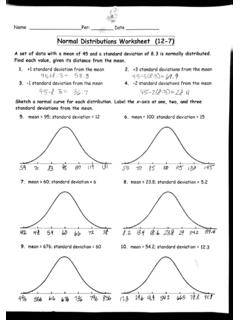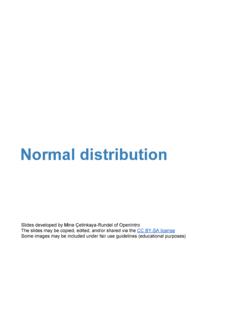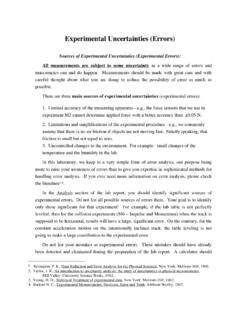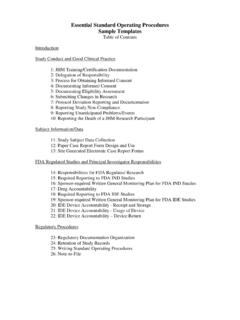Transcription of Standard errors of regression coefficients
1 Standard errors of regression coefficients PRECISION OF THE regression coefficients . Simple regression model: Y = b1 + b2X + u probability density function of b 2. Standard deviation of density function of b 2. b2 b 2. We have seen that the regression coefficients b 1 and b 2 are random variables. They provide point estimates of b1 and b2, respectively. In the last sequence we demonstrated that these point estimates are unbiased. 1. PRECISION OF THE regression coefficients . Simple regression model: Y = b1 + b2X + u probability density function of b 2. Standard deviation of density function of b 2. b2 b 2. In this sequence we will see that we can also obtain estimates of the Standard deviations of the distributions. These will give some idea of their likely reliability and will provide a basis for tests of hypotheses. 2. PRECISION OF THE regression coefficients . Simple regression model: Y = b1 + b2X + u . 1 X 2.
2 S b2 = su +. 2. 2 . n ( X i - X ) . 1. s u2 s u2. s b2 = =. 2. ( X i - X). 2. n MSD ( X ). Expressions (which will not be derived) for the variances of their distributions are shown above. b 2. 3. PRECISION OF THE regression coefficients . Simple regression model: Y = b1 + b2X + u . 1 X 2 . s b2 = su +. 2. 2 . n ( X i - X ) . 1. s u2 s u2. s b2 = =. 2. ( X i - X). 2. n MSD ( X ). We will focus on the implications of the expression for the variance of b 2. Looking at the numerator, we see that the variance of b 2 is proportional to s u . This is as we would expect. 2. The more noise there is in the model, the less precise will be our estimates. 4. PRECISION OF THE regression coefficients . Simple regression model: Y = b1 + b2X + u Y = + Y Y. 20 regression line 20 regression line 15 15. 10 10. 5 nonstochastic relationship 5 nonstochastic relationship 0 0. 0 5 10 15 20 X 0 5 10 15 20 X. -5 -5. -10 -10. This is illustrated by the diagrams above.
3 The nonstochastic component of the relationship, Y = + , represented by the dotted line, is the same in both diagrams. 5. PRECISION OF THE regression coefficients . Simple regression model: Y = b1 + b2X + u Y = + Y Y. 20 regression line 20 regression line 15 15. 10 10. 5 nonstochastic relationship 5 nonstochastic relationship 0 0. 0 5 10 15 20 X 0 5 10 15 20 X. -5 -5. -10 -10. The values of X are the same, and the same random numbers have been used to generate the values of the disturbance term in the 20 observations. 6. PRECISION OF THE regression coefficients . Simple regression model: Y = b1 + b2X + u Y = + Y Y. 20 regression line 20 regression line 15 15. 10 10. 5 nonstochastic relationship 5 nonstochastic relationship 0 0. 0 5 10 15 20 X 0 5 10 15 20 X. -5 -5. -10 -10. However, in the right-hand diagram the random numbers have been multiplied by a factor of 5. As a consequence, the regression line, the solid line, is a much poorer approximation to the nonstochastic relationship.
4 7. PRECISION OF THE regression coefficients . Simple regression model: Y = b1 + b2X + u . 1 X 2 . s b2 = su +. 2. 2 . n ( X i - X ) . 1. s u2 s u2. s b2 = =. 2. ( X i - X). 2. n MSD ( X ). Looking at the denominator of the expression for the variance of b 2 , the larger is the sum of the squared deviations of X, the smaller is the variance of b 2 . 8. PRECISION OF THE regression coefficients . Simple regression model: Y = b1 + b2X + u . 1 X 2 . s b2 = su +. 2. 2 . n ( X i - X ) . 1. s u2 s u2. s b2 = =. 2. ( X i - X). 2. n MSD ( X ). 1. MSD ( X ) = ( i ). 2. X - X. n However, the size of the sum of the squared deviations depends on two factors: the number of observations, and the size of the deviations of Xi about its sample mean. To discriminate between them, it is convenient to define the mean square deviation of X, MSD(X). 9. PRECISION OF THE regression coefficients . Simple regression model: Y = b1 + b2X + u.
5 1 X 2 . s b2 = su +. 2. 2 . n ( X i - X ) . 1. s u2 s u2. s b2 = =. 2. ( X i - X). 2. n MSD ( X ). 1. MSD ( X ) = ( i ). 2. X - X. n From the expression as rewritten, it can be seen that the variance of b 2 is inversely proportional to n, the number of observations in the sample, controlling for MSD(X). The more information you have, the more accurate your estimates are likely to be. 10. PRECISION OF THE regression coefficients . Simple regression model: Y = b1 + b2X + u . 1 X 2 . s b2 = su +. 2. 2 . n ( X i - X ) . 1. s u2 s u2. s b2 = =. 2. ( X i - X). 2. n MSD ( X ). 1. MSD ( X ) = ( i ). 2. X - X. n A third implication of the expression is that the variance is inversely proportional to the mean square deviation of X. What is the reason for this? 11. PRECISION OF THE regression coefficients . Simple regression model: Y = b1 + b2X + u Y = + Y Y. 20 regression line 20 regression line 15 15. 10 10. 5 nonstochastic relationship 5 nonstochastic relationship 0 0.
6 0 5 10 15 20 X 0 5 10 15 20 X. -5 -5. -10 -10. In the diagrams above, the nonstochastic component of the relationship is the same and the same random numbers have been used for the 20 values of the disturbance term. 12. PRECISION OF THE regression coefficients . Simple regression model: Y = b1 + b2X + u Y = + Y Y. 20 regression line 20 regression line 15 15. 10 10. 5 nonstochastic relationship 5 nonstochastic relationship 0 0. 0 5 10 15 20 X 0 5 10 15 20 X. -5 -5. -10 -10. However, MSD(X) is much smaller in the right-hand diagram because the values of X are much closer together. 13. PRECISION OF THE regression coefficients . Simple regression model: Y = b1 + b2X + u Y = + Y Y. 20 regression line 20 regression line 15 15. 10 10. 5 nonstochastic relationship 5 nonstochastic relationship 0 0. 0 5 10 15 20 X 0 5 10 15 20 X. -5 -5. -10 -10. Hence in that diagram the position of the regression line is more sensitive to the values of the disturbance term, and as a consequence the regression line is likely to be relatively inaccurate.
7 14. PRECISION OF THE regression coefficients . Simple regression model: Y = b1 + b2X + u Y = + 10. X = 1, 2, .., 20. 5. X = , , .., 11. 10 million samples 0. -1 0 1 b 2. The figure shows the distributions of the estimates of b 2 for X = 1, 2, .., 20 and X = , , .., 11 in a simulation with 10 million samples. 15. PRECISION OF THE regression coefficients . Simple regression model: Y = b1 + b2X + u Y = + 10. X = 1, 2, .., 20. 5. X = , , .., 11. 10 million samples 0. -1 0 1 b 2. It confirms that the distribution of the estimates obtained with the high dispersion of X has a much smaller variance than that with the low dispersion of X. 16. PRECISION OF THE regression coefficients . Simple regression model: Y = b1 + b2X + u . 2 1 X2 s u2 s u2. s b2 = su + 2 s b2 = =. 1. n ( X i - X ) . 2. ( X i - X). 2. n MSD ( X ). Of course, as can be seen from the variance expressions, it is really the ratio of the MSD(X). to the variance of u which is important, rather than the absolute size of either.
8 17. PRECISION OF THE regression coefficients . Simple regression model: Y = b1 + b2X + u . 2 1 X2 s u2 s u2. s b2 = su + 2 s b2 = =. 1. n ( X i - X ) . 2. ( X i - X). 2. n MSD ( X ). We cannot calculate the variances exactly because we do not know the variance of the disturbance term. However, we can derive an estimator of s u from the residuals. 2. 18. PRECISION OF THE regression coefficients . Simple regression model: Y = b1 + b2X + u . 2 1 X2 s u2 s u2. s b2 = su + 2 s b2 = =. 1. n ( X i - X ) . 2. ( X i - X). 2. n MSD ( X ). Clearly the scatter of the residuals around the regression line will reflect the unseen scatter of u about the line Yi = b1 + b2Xi, although in general the residual and the value of the disturbance term in any given observation are not equal to one another. 19. PRECISION OF THE regression coefficients . Simple regression model: Y = b1 + b2X + u . 2 1 X2 s u2 s u2. s b2 = su + 2 s b2 = =.
9 1. n ( X i - X ) . 2. ( X i - X). 2. n MSD ( X ). 1 1. MSD ( u ) = i ( ) i 2.. u - . u = . u 2. n n One measure of the scatter of the residuals is their mean square error, MSD(u ), defined as shown. (Remember that the mean of the OLS residuals is equal to zero). Intuitively this should provide a guide to the variance of u. 20. PRECISION OF THE regression coefficients . Simple regression model: Y = b1 + b2X + u . 2 1 X2 s u2 s u2. s b2 = su + 2 s b2 = =. 1. n ( X i - X ) . 2. ( X i - X). 2. n MSD ( X ). 1 1. MSD ( u ) = i ( ) i 2.. u - . u = . u 2. n n Before going any further, ask yourself the following question. Which line is likely to be closer to the points representing the sample of observations on X and Y, the true line Y = b1 + b2X or the regression line Y = b 1 + b 2 X ? 21. PRECISION OF THE regression coefficients . Simple regression model: Y = b1 + b2X + u . 2 1 X2 s u2 s u2. s b2 = su + 2 s b2 = =. 1.
10 N ( X i - X ) . 2. ( X i - X). 2. n MSD ( X ). 1 1. MSD ( u ) = i ( ) i 2.. u - . u = . u 2. n n The answer is the regression line, because by definition it is drawn in such a way as to minimize the sum of the squares of the distances between it and the observations. 22. PRECISION OF THE regression coefficients . Simple regression model: Y = b1 + b2X + u . 2 1 X2 s u2 s u2. s b2 = su + 2 s b2 = =. 1. n ( X i - X ) . 2. ( X i - X). 2. n MSD ( X ). 1 1. MSD ( u ) = i ( ) i 2.. u - . u = . u 2. n n Hence the spread of the residuals will tend to be smaller than the spread of the values of u, and MSD(u ) will tend to underestimate s u . 2. 23. PRECISION OF THE regression coefficients . Simple regression model: Y = b1 + b2X + u . 2 1 X2 s u2 s u2. s b2 = su + 2 s b2 = =. 1. n ( X i - X ) . 2. ( X i - X). 2. n MSD ( X ). 1 1. MSD ( u ) = i ( ) i 2.. u - . u = . u 2. n n n-2 2. E ( MSD ( u ) ) = su n Indeed, it can be shown that the expected value of MSD(u ), when there is just one explanatory variable, is given by the expression above.






